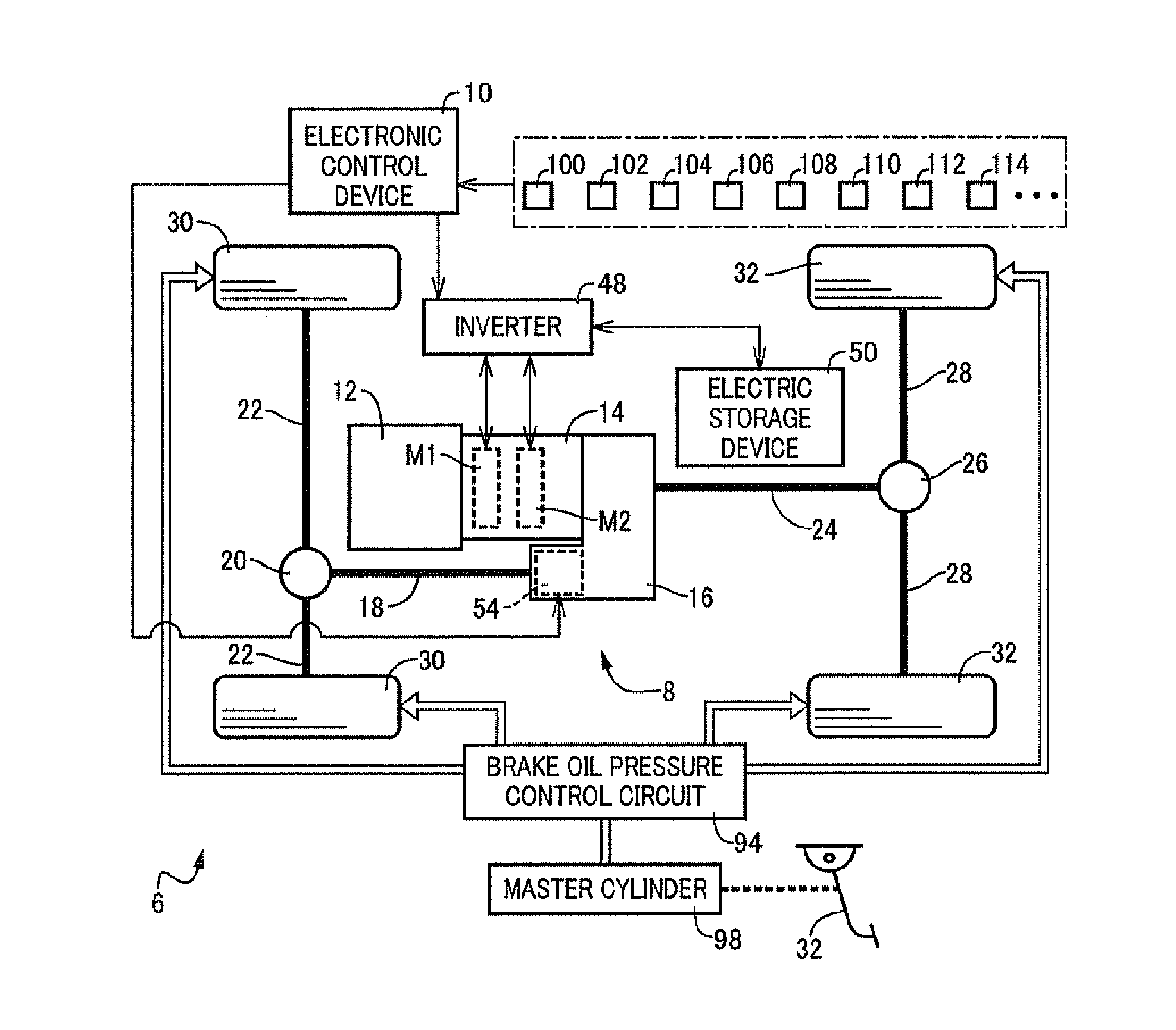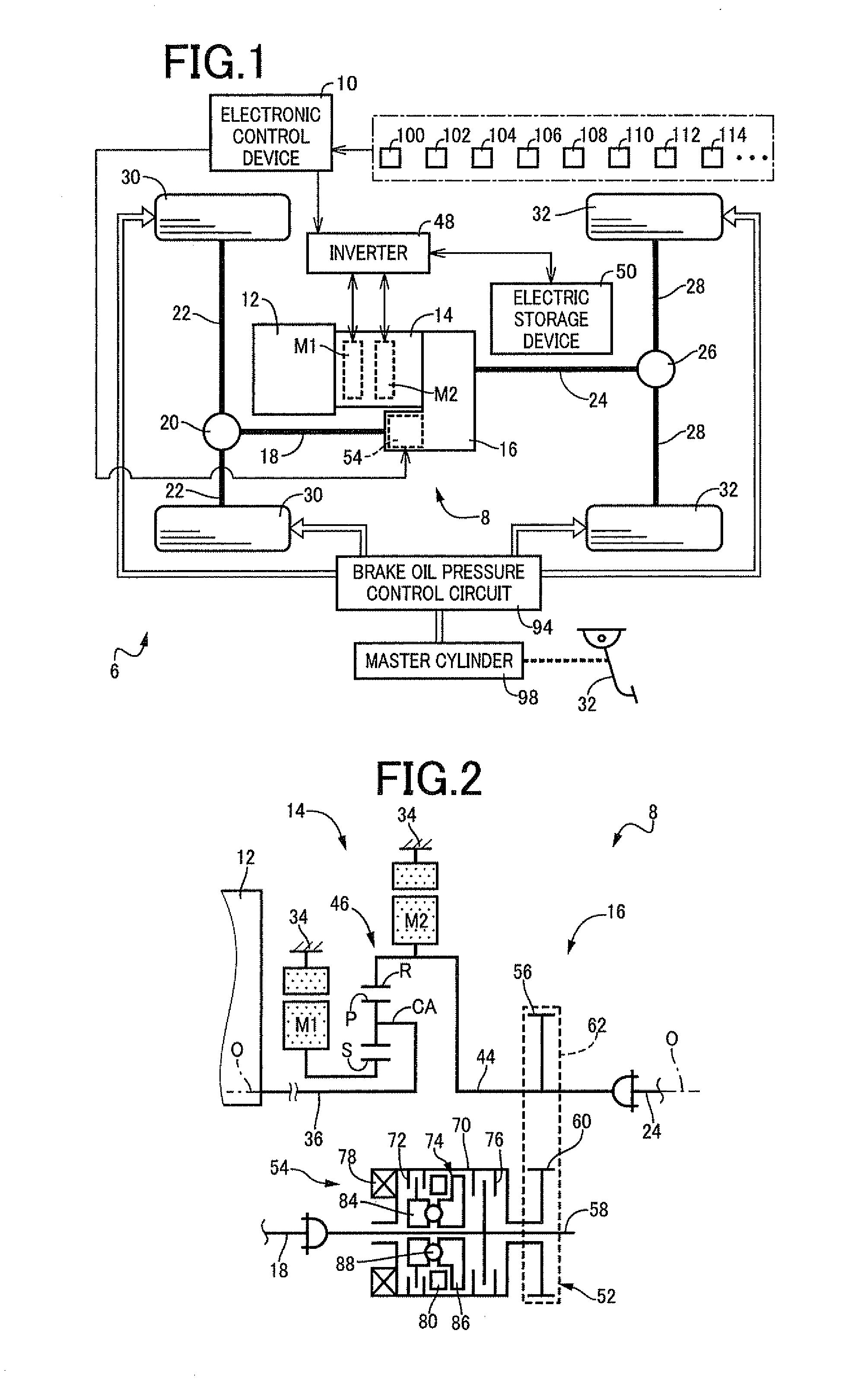Drive control device for standby four-wheel drive vehicle
a four-wheel drive, control device technology, applied in vehicle position/course/altitude control, process and machine control, instruments, etc., can solve the problems and preventing the improvement of fuel economy. , to achieve the effect of reducing the regenerative efficiency of the motor generator, reducing the regenerative efficiency of the motor, and increasing the electric power consumed for operating the clutch devi
- Summary
- Abstract
- Description
- Claims
- Application Information
AI Technical Summary
Benefits of technology
Problems solved by technology
Method used
Image
Examples
first embodiment
[0031]FIG. 1 is a diagram for explaining a vehicle driving device 8 and an electronic control device 10 for the control thereof disposed on a standby four-wheel drive vehicle 6 according to one embodiment of the present invention. The electronic control device 10 corresponds to a drive control device of the present invention. The vehicle driving device 8 of this embodiment is preferably used in a hybrid vehicle that employs a standby 4WD system based on a front-engine rear-drive system (FR).
[0032]In FIG. 1, a drive force (drive torque) generated by an engine 12 is transmitted via a power transmission device 14 described later to a transfer 16. The drive force transmitted to the transfer 16 is distributed to a front propeller shaft 18 and a rear propeller shaft 24. The drive force transmitted to the front propeller shaft 18 is transmitted via a front-wheel differential gear device 20 and front-wheel axles 22 to a pair of left and right front-side drive wheels (front drive wheels) 30....
second embodiment
[0076]Another embodiment of the present invention will be described. In the following description of the embodiment, the portions overlapped with the embodiment described above will be denoted by the same reference numerals and will not be described.
[0077]In FIG. 4, when determining whether the value acquired by subtracting the predetermined differential rotation number correction value k1 from the front-wheel rotation speed Nf exceeds the rear-wheel rotation speed Nr, if the determination is negative, the transmission torque control means 126 of this embodiment fixes the control coupling torque Tc of the control coupling device 54 to a value when the above determination is affirmative so as to increase the rear-wheel regenerative braking torque Tr. When the determination is negative and control coupling torque Tc is fixed to a given value, the transmission torque control means 126 determines whether the regenerative braking command torque Tko exceeds the regeneration limit torque T...
third embodiment
[0093]In FIG. 4, when determining whether the value acquired by subtracting the differential rotation number correction value k1 from the front-wheel rotation speed Nf exceeds the rear-wheel rotation speed Nr, if the determination is affirmative, the transmission torque control means 126 of this embodiment calculates respective loads acting on the front-side drive wheels 30 and the rear-side drive wheels 32, i.e., a front-wheel affecting load Ff and a rear-wheel affecting load Fr, based on a deceleration G of the vehicle supplied from the acceleration sensor in accordance with a relationship stored in advance, i.e., the following Equations (1) to (3). In the following Equations (1) to (3), Wf is a load acting on the front-side drive wheels 30 when the standby four-wheel drive vehicle 6 remains still on a level road surface, i.e., a static front-wheel load. Wr is a load acting on the rear-side drive wheels 30 when the standby four-wheel drive vehicle 6 remains still on a level road s...
PUM
 Login to View More
Login to View More Abstract
Description
Claims
Application Information
 Login to View More
Login to View More - R&D
- Intellectual Property
- Life Sciences
- Materials
- Tech Scout
- Unparalleled Data Quality
- Higher Quality Content
- 60% Fewer Hallucinations
Browse by: Latest US Patents, China's latest patents, Technical Efficacy Thesaurus, Application Domain, Technology Topic, Popular Technical Reports.
© 2025 PatSnap. All rights reserved.Legal|Privacy policy|Modern Slavery Act Transparency Statement|Sitemap|About US| Contact US: help@patsnap.com



